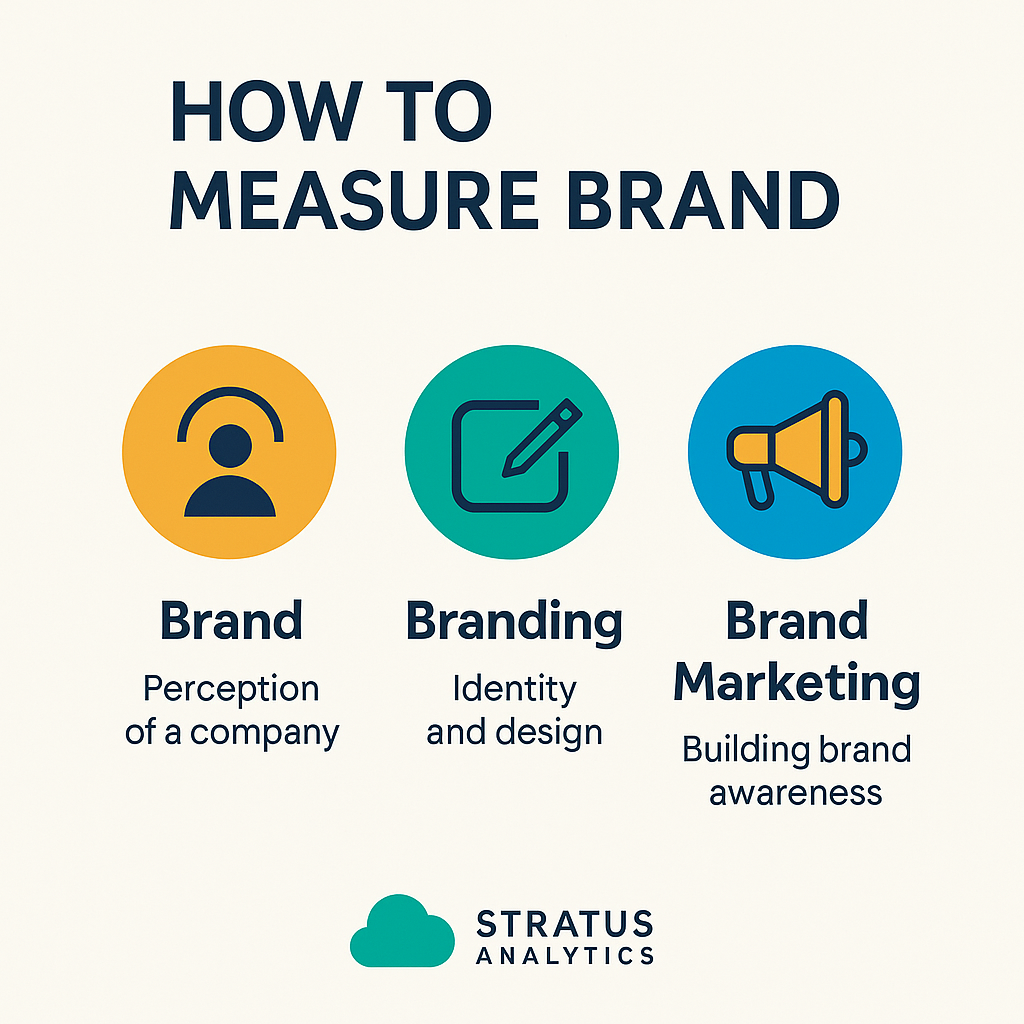“How do I measure brand?”
It is one of the most common questions marketing leaders, especially VPs and CMOs, ask.
It is also one of the most misunderstood topics in marketing.
The truth is, before you can even attempt to measure brand effectively, you must first start by asking a better question. Too often, marketers jump into tracking fuzzy metrics without clearly defining what they mean by “brand,” “branding,” and “brand marketing.” The result is a muddled set of KPIs that fail to drive business value.
In this post, we will break down:
- Why brand, branding, and brand marketing are not the same
- How to connect brand-building activities to real business outcomes
- A simple geo-testing method to prove the impact of brand efforts
If you are a marketing leader who is tired of vague benchmarks and fluffy vanity metrics, this guide is for you.

Why “Brand,” “Branding,” and “Brand Marketing” Are Not the Same
Before measuring brand, it is critical to understand the differences between three related but distinct concepts: brand, branding, and brand marketing.
Brand
Brand is the collective perception of your company in the minds of your customers, prospects, and the broader market. It is how people feel about your business. It is not something you own or control directly. It exists in the minds of others.
Brand includes:
- Reputation
- Associations
- Trust
- Emotional connection
- Loyalty
In simple terms, brand is the gut feeling people have when they think about your company.
Branding
Branding is the set of actions and assets you use to influence that perception. Branding includes:
- Your visual identity (logo, colors, typography)
- Your messaging and tone of voice
- Your website and marketing collateral
- Your customer experience touchpoints
Branding is what you control. It is the effort you make to shape the brand perception.
Brand Marketing
Brand marketing refers to the specific campaigns and initiatives designed to build awareness, favorability, and preference over time. This might include:
- Paid media campaigns focused on storytelling rather than direct response
- Sponsorships
- Content marketing
- Organic social media
- PR and earned media efforts
Brand marketing is about scaling the reach of your branding efforts and reinforcing your desired brand positioning over time.
Why These Distinctions Matter
If you treat all three of these as the same thing, you risk measuring the wrong activities. Measuring your brand is different from measuring branding efforts or brand marketing campaigns.
Clarifying these definitions upfront ensures you match your measurement approach to the right objectives.
How to Connect Brand to Real Business Outcomes
Once you understand the difference between brand, branding, and brand marketing, the next step is tying brand investments to tangible business results. This is where many teams struggle.
The key is to view brand as a driver of future cash flows and market share, not just soft engagement metrics.
Here is how you can do it.
1. Identify Brand-Led Business Outcomes
Start by clarifying what brand growth should impact. Some examples include:
- Increased unaided brand awareness
- Higher website direct traffic
- Higher branded search volume
- Improved win rates in competitive sales situations
- Higher customer lifetime value (CLV)
- Lower customer acquisition cost (CAC) over time
- Stronger talent acquisition and employee retention
Each of these outcomes contributes directly or indirectly to revenue and profitability.
2. Establish a Baseline
Before launching a brand campaign or initiative, benchmark key indicators. Some examples include:
- Brand awareness surveys
- Direct and branded search traffic analytics
- Share of voice compared to competitors
- Sentiment analysis on social media and review sites
Without a baseline, you will not be able to attribute changes to your brand efforts later.
3. Monitor Leading and Lagging Indicators
Brand impacts both leading and lagging indicators.
Leading indicators are early signs that brand perception is improving, such as:
- An uptick in branded searches
- More direct visits to your website
- More followers and engagement on brand-related content
Lagging indicators are the ultimate business outcomes, such as:
- Revenue growth
- Improved sales efficiency
- Greater market share
- Customer retention rates
Both types of indicators are important. Leading indicators help you optimize in real time. Lagging indicators prove business impact over the long term.
4. Combine Quantitative and Qualitative Insights
Quantitative data gives you the hard numbers. Qualitative data gives you context.
Quantitative measures:
- Surveys asking brand recall and favorability
- Website analytics for direct and branded traffic
- Media spend versus share of voice
- Conversion rates across stages
Qualitative measures:
- Customer interviews
- Sales team feedback about changes in prospect conversations
- Reviews and testimonials mentioning brand elements
Using both types of insights creates a fuller picture of how your brand is performing.
A Dead-Simple Geo Test to Prove Brand Impact
One of the simplest and most powerful methods to isolate the effect of brand marketing is a geo test. This approach is easy to implement and delivers clear directional data.
Here is how to run a basic geo-based brand lift test:
Step 1: Select Test and Control Markets
Choose two similar markets that are demographically and economically comparable. One market will receive your brand campaign (test group) while the other will not (control group).
Ensure the markets are large enough to generate meaningful data but small enough to be manageable.
Step 2: Launch Brand Campaign in the Test Market Only
Deploy your brand marketing campaign — whether it is paid media, out-of-home advertising, or localized sponsorships — only in the test market. Keep marketing activities in the control market minimal or unchanged.
Step 3: Measure Pre- and Post-Campaign Metrics
Track both leading and lagging indicators in both markets over time. Key metrics might include:
- Branded search volume
- Direct website traffic
- Social media engagement
- CRM lead volume by market
- Sales opportunity creation
- Win rates
Step 4: Analyze the Differences
After the campaign concludes, compare changes between the test and control groups.
If the test market shows a statistically significant improvement across brand-related metrics without corresponding gains in the control market, you have strong evidence that your brand efforts made an impact.
Step 5: Use Insights to Scale
If the geo test is successful, use the insights to justify scaling the brand campaign to broader markets. If the test is inconclusive, refine the messaging, creative, or targeting before investing more.
Common Mistakes When Measuring Brand (And How to Avoid Them)
Even with good intentions, it is easy to make mistakes when measuring brand initiatives. Here are some common pitfalls to watch for.
Mistake 1: Measuring Too Soon
Brand building is a long-term game. Expecting massive shifts in business metrics within a few weeks sets you up for disappointment. Allow sufficient time for awareness and perception changes to translate into business results.
Mistake 2: Chasing Vanity Metrics
Focusing only on likes, shares, and surface-level engagement metrics can distract from real business outcomes. Ensure your measurement framework connects brand activities to revenue-related indicators.
Mistake 3: Ignoring Market Context
If competitors launch massive brand campaigns at the same time, it may skew your data. Always consider market activity when interpreting results.
Mistake 4: Failing to Align Internally
If leadership does not understand how brand efforts tie to business goals, it will be difficult to secure long-term support. Educate stakeholders on the strategic role of brand growth and the timelines involved.
Conclusion: Measuring Brand Is About Asking the Right Questions
If you want to measure brand properly, you must start with better questions:
- What are we trying to influence?
- How will we know if we are making progress?
- How will brand growth contribute to business outcomes?
By distinguishing between brand, branding, and brand marketing, connecting brand initiatives to measurable business drivers, and using simple tests like geo lifts, marketing leaders can finally cut through the fuzziness.
Brand is not just a “nice to have.” It is a critical asset that impacts awareness, trust, revenue, and long-term profitability.
When measured thoughtfully, brand investments can be one of the most powerful levers for sustainable business growth.

Hi there! I’m Scott, and I am the principal consultant and thought leader behind Stratus Analytics. I have a Master of Science degree in marketing analytics, and I’ve have been providing freelance digital marketing services for over 20 years. Additionally, I have written several books on marketing which you can find here on Amazon or this website.
DISCLAIMER: Due to my work in the packaging industry, I cannot take on freelance clients within the packaging manufacturing space. I do not want to provide disservice to your vision or my employer. Thank you for understanding.
